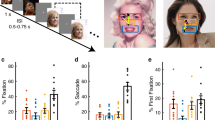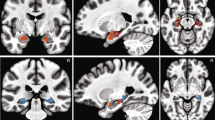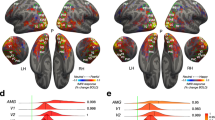Abstract
The amygdala is important for face processing, and direction of eye gaze is one of the most socially salient facial signals. Recording from over 200 neurons in the amygdala of neurosurgical patients, we found robust encoding of the identity of neutral-expression faces, but not of their direction of gaze. Processing of gaze direction may rely on a predominantly cortical network rather than the amygdala.
This is a preview of subscription content, access via your institution
Access options
Subscribe to this journal
Receive 12 print issues and online access
$209.00 per year
only $17.42 per issue
Buy this article
- Purchase on Springer Link
- Instant access to full article PDF
Prices may be subject to local taxes which are calculated during checkout


Similar content being viewed by others
References
Emery, N.J. Neurosci. Biobehav. Rev. 24, 581–604 (2000).
Nummenmaa, L. & Calder, A. Trends Cogn. Sci. 13, 135–143 (2009).
Young, A.W. et al. Brain 118, 15–24 (1995).
Adolphs, R., Tranel, D. & Damasio, A.R. Nature 393, 470–474 (1998).
Kawashima, R. et al. Brain 122, 779–783 (1999).
Straube, T., Langohr, B., Schmidt, S., Metzel, H.-J. & Miltner, W.H.R. Neuroimage 49, 2680–2686 (2010).
Sauer, A., Mothes-Lasch, M., Miltner, W.H.R. & Straube, T. Soc. Cogn. Affect. Neurosci. 9, 1246–1252 (2014).
Hooker, C.I. et al. Brain Res. Cogn. Brain Res. 17, 406–418 (2003).
Nummenmaa, L., Engell, A.D., von dem Hagen, E.A.H., Henson, R.N.A. & Calder, A.J. Neuroimage 59, 3356–3363 (2012).
Tottenham, N. et al. Soc. Cogn. Affect. Neurosci. 9, 106–117 (2014).
Rutishauser, U. et al. Neuron 80, 887–899 (2013).
Adams, R.B., Gordon, H.L., Baird, A.A., Ambady, N. & Kleck, R.E. Science 300, 1536 (2003).
Kreiman, G., Koch, C. & Fried, I. Nat. Neurosci. 3, 946–953 (2000).
Kriegeskorte, N. et al. Neuron 60, 1126–1141 (2008).
Brothers, L. & Ring, B. Behav. Brain Res. 57, 53–61 (1993).
Tazumi, T., Hori, E., Maior, R.S., Ono, T. & Nishijo, H. Neuroscience 169, 287–301 (2010).
Hoffman, K.L., Gothard, K.M., Schmid, M.C. & Logothetis, N.K. Curr. Biol. 17, 766–772 (2007).
Mosher, C.P., Zimmerman, P.E. & Gothard, K.M. Curr. Biol. 24, 2459–2464 (2014).
Sato, W. et al. PLoS ONE 6, e28188 (2011).
Whalen, P.J. et al. Science 306, 2061 (2004).
Mormann, F. et al. Nat. Neurosci. 14, 1247–1249 (2011).
Quiroga, R.Q., Nadasdy, Z. & Ben-Shaul, Y. Neural Comput. 16, 1661–1687 (2004).
Jenkinson, M., Beckmann, C.F., Behrens, T.E., Woolrich, M.W. & Smith, S.M. Neuroimage 62, 782–790 (2012).
Kiani, R., Esteky, H., Mirpour, K. & Tanaka, K. J. Neurophysiol. 97, 4296–4309 (2007).
Kriegeskorte, N. et al. Neuron 60, 1126–1141 (2008).
Acknowledgements
We thank all patients for their participation and B. Samimizad for assistance with the spike sorting. This research was supported by the Volkswagen Foundation and the German Research Council (DFG, MO 930/4-1 and SFB 1089), a Conte Center grant from NIMH (P50 MH094258), and a grant from the Simons Foundation (SFARI Director's award).
Author information
Authors and Affiliations
Contributions
F.M. and R.A. designed the study. F.M. and O.T. implemented the experimental procedure. V.A.C. and F.M. carried out the neurosurgical procedures. F.M. and J.N. collected the electrophysiological data. F.M. analyzed the electrophysiological data. C.M.Q., J.N., C.E.E. and F.M. verified electrode locations. R.A. and F.M. wrote the paper. All of the authors discussed the results and commented on the manuscript.
Corresponding author
Ethics declarations
Competing interests
The authors declare no competing financial interests.
Integrated supplementary information
Supplementary Figure 1 Localization of microwire bundles.
(a) The tips of the microwire bundles were localized using a post-implantational CT scan coregistered and fused with a pre-implantational MRI scan, normalized to MNI (Montreal Neurological Institute) space. (b) Recording sites (i.e., locations of bundle tips) projected onto an axial (left) and a coronal (right) section of the averaged MNI-normalized MRI scans from 14 subjects. All 31 recording sites were individually verified to be located in the basolateral amygdala. See Supplementary Table 2 for MNI coordinates. R, right.
Supplementary Figure 2 Stimuli used in the static face protocol.
(a) The 5 person identities used; (b) the 9 eye gaze directions; (c) the 9 head directions.
Supplementary Figure 3 Response histograms to different persons and head/gaze directions averaged across all 223 amygdala units.
(a-d) Responses separated by person identity for all presented, only vertical, only right, only left head/gaze directions, respectively. (e) Responses during the 'live encounter' with the experimenter (stimulus person 5). See also Figure 1.
Supplementary Figure 4 Amygdala responses to gaze direction and person identity.
The matrix shows z-scored color-coded mean responses from all 223 amygdala units to nine gaze directions from five persons as presented in the picture task. (a) Responses arranged by person identity. (b) Responses arranged by gaze direction. See also Figure 2.
Supplementary Figure 5 Stimulus preference of units showing a significant main effect of person identity in the ANOVA.
Displayed in color code are the z-scored average responses to each of the five presented persons in all four regions of the MTL.
Supplementary Figure 6 Visual response selectivity of amygdala neurons.
Visual response selectivity of amygdala neurons, from a separate task performed in 13 of the 14 patients. (a) Response probabilities of 384 units (126 single-units) to faces and non-faces. Error bars denote binomial 68% confidence intervals. (b) Mean response magnitudes (z-scored) of all 81 responsive units (28 SU) to faces and non-faces. Error bars denote S.E.M. (c) Scatter plot showing response probabilities to faces and non-faces for each of the 81 responsive units. (d) Scatter plot showing mean response magnitude to faces and non-faces. Please note that all data shown here were acquired on a separate day from our main experiment; consequently it is unknown which of the neurons shown here would be identical to neurons we recorded from in our main task.
Supplementary Figure 7 Setup for face-to-face (live encounter) experiment.
The experimenter sat 80-100 cm away from the patient. The patient sat upright in his bed, and the experimenter upright on a chair next to the bed at the same height as the patient.
Supplementary information
Supplementary Text and Figures
Supplementary Figures 1–7 and Supplementary Tables 1–3 (PDF 1055 kb)
Rights and permissions
About this article
Cite this article
Mormann, F., Niediek, J., Tudusciuc, O. et al. Neurons in the human amygdala encode face identity, but not gaze direction. Nat Neurosci 18, 1568–1570 (2015). https://doi.org/10.1038/nn.4139
Received:
Accepted:
Published:
Issue Date:
DOI: https://doi.org/10.1038/nn.4139
This article is cited by
-
Single-neuron mechanisms of neural adaptation in the human temporal lobe
Nature Communications (2023)
-
Face Recognition
Current Neurology and Neuroscience Reports (2019)



